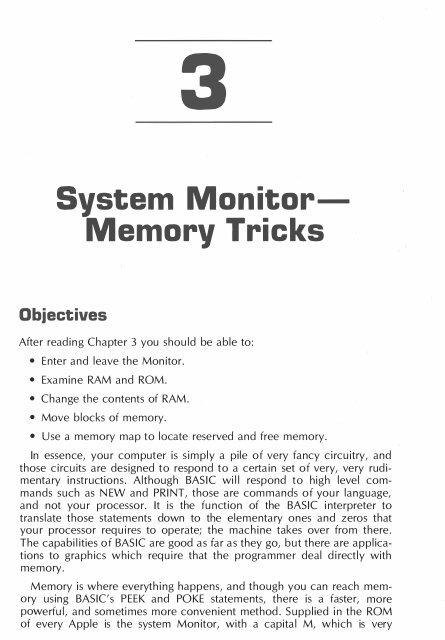- Page 3 and 4: APPLE IICOMPUTERGRAPHICSKen William
- Page 5 and 6: Contents1 Introduction 12 Computer
- Page 7 and 8: 1IntroductionThe level of graphics
- Page 10 and 11: 4 APPLE II COMPUTER GRAPHICSmachine
- Page 12 and 13: 6 APPLE II COMPUTER GRAPHICScompute
- Page 14 and 15: 8 APPLE II COMPUTER GRAPHICSzeros i
- Page 16 and 17: 10 APPLE II COMPUTER GRAPHICSthe sy
- Page 20 and 21: 14 APPLE II COMPUTER GRAPHICSdiffer
- Page 22 and 23: 16 APPLE II COMPUTER GRAPHICSDOS ve
- Page 24 and 25: 18 APPLE II COMPUTER GRAPHICSThe po
- Page 27 and 28: 4APP LESO FTExtensionsObjectivesAft
- Page 29 and 30: CHAPTER 4-APPLESOFT EXTENSIONS 23va
- Page 31 and 32: CHAPTER 4-APPLESOFT EXTENSIONS 251
- Page 33 and 34: CHAPTER 4-APPLESOFT EXTENSIONS 2710
- Page 35 and 36: Introducing -Diskette to Accompany
- Page 37 and 38: CHAPTER 4-APPLESOFT EXTENSIONS 2917
- Page 39 and 40: 5Graphics Modes andSoft SwitchesObj
- Page 41 and 42: CHAPTER 5-CRAPHIC MODES AND SOFT SW
- Page 43 and 44: CHAPTER 5-GRAPHIC MODES AND SOFT SW
- Page 45: CHAPTER 5-CRAPHIC MODES AND SOFT SW
- Page 48 and 49: 40 APPLE II COMPUTER GRAPHICSthe le
- Page 50 and 51: 42 APPLE II COMPUTER GRAPHICSSoluti
- Page 52 and 53: 44 APPLE II COMPUTER GRAPHICSEach b
- Page 54 and 55: ..46 APPLE II COMPUTER GRAPHICS[ b
- Page 56 and 57: 48 APPLE II COMPUTER GRAPHICS3 PLOT
- Page 58 and 59: 50 APPLE II COMPUTER GRAPHICSType t
- Page 60 and 61: 52 APPLE II COMPUTER GRAPHICSVocabu
- Page 62 and 63: 54 APPLE II COMPUTER GRAPHICScolor.
- Page 64 and 65: 56 APPLE II COMPUTER GRAPHICSThis m
- Page 66 and 67: 58 APPLE II COMPUTER GRAPHICSmuch l
- Page 68 and 69:
60 APPLE II COMPUTER GRAPHICS70 POK
- Page 70 and 71:
62 APPLE II COMPUTER GRAPHICS37- 85
- Page 73 and 74:
8Hi-Res GraphicsObjectivesAfter rea
- Page 75 and 76:
CHAPTER 8-Hl-RES GRAPHICS 67When J
- Page 77 and 78:
C..: HAPTER 8-Hl-RES GRAPHICS 69Goi
- Page 79 and 80:
CHAPTER 8-Hl-RES GRAPHICS 71Row Add
- Page 81 and 82:
CHAPTER 8-Hl-RES GRAPHICS 73The fou
- Page 83 and 84:
CHAPTER 8-Hl-RES GRAPHICS 75The row
- Page 85 and 86:
CHAPTER 8-Hl-RES GRAPHICS 77Solutio
- Page 87:
CHAPTER 8-Hl-RES GRAPHICS 79b. XX-X
- Page 90 and 91:
82 APPLE II COMPUTER GRAPHICSA Bit
- Page 92 and 93:
84 -APPLE II COMPUTER GRAPHICSget t
- Page 94 and 95:
86 APPLE II COMPUTER GRAPHICSDOTBIT
- Page 96 and 97:
88 APPLE II COMPUTER GRAPHICSIn Fig
- Page 98 and 99:
90 APPLE II COMPUTER GRAPHICSblue a
- Page 100 and 101:
92 APPLE II COMPUTER GRAPHICSHEX HE
- Page 102 and 103:
94 APPLE II COMPUTER GRAPHICS50 HGR
- Page 104 and 105:
96 APPLE II COMPUTER GRAPHICSone of
- Page 107 and 108:
991 111ObjectivesAfter reading Chap
- Page 109 and 110:
CHAPTER 10-SHAPING UP 101A closed d
- Page 111 and 112:
CHAPTER 10-SHAPING UP 103In the fir
- Page 113 and 114:
CHAPTER 10-SHAPING UP 105( (J(J) ha
- Page 115 and 116:
CHAPTER 10-SHAPING UP 107as the com
- Page 117 and 118:
6 POKE 232,: POKE 233 ,37 REM8 REM
- Page 119 and 120:
CHAPTER 10-SHAPING UP 111Sections A
- Page 121 and 122:
CHAPTE R 10-SHAPING UP 113DRAW 2 AT
- Page 123 and 124:
CHAPTER 10-SHAPING UP 115printed at
- Page 125:
CHAPTER 10-SHAPING UP 117Exercises1
- Page 128 and 129:
120 APPLE II COMPUTER GRAPHICS1 REM
- Page 130 and 131:
122 APPLE II COMPUTER GRAPHICSLet's
- Page 132 and 133:
124 APPLE II COMPUTER GRAPHICSJ28 :
- Page 134 and 135:
126 APPLE II COMPUTER GRAPHICS670 X
- Page 136 and 137:
128 APPLE II COMPUTER GRAPHICS71¥l
- Page 138 and 139:
130 APPLE II COMPUTER GRAPHICS100 R
- Page 140 and 141:
132 APPLE II COMPUTER GRAPHICSAs we
- Page 143 and 144:
12Byte-Move ShapesObjectivesAfter r
- Page 145 and 146:
CHAPTER 12-BYTE-MOVE SHAPES 13729JJ
- Page 147 and 148:
CHAPTER 12-BYTE-MOVE SHAPES 139l!il
- Page 149 and 150:
CHAPTER 12-BYTE-MOVE SHAPES 141POKE
- Page 151 and 152:
CHAPTER 12-BYTE-MOVE SHAPES 1431BYT
- Page 153:
CHAPTER 12-BYTE-MOVE SHAPES 145Agai
- Page 156 and 157:
148 APPLE II COMPUTER GRAPHICSprovi
- Page 158 and 159:
150 APPLE II COMPUTER GRAPHICSaroun
- Page 160 and 161:
152 APPLE II COMPUTER GRAPHICS3 : 2
- Page 162 and 163:
154 APPLE II COMPUTER GRAPHICSdesir
- Page 164 and 165:
156 APPLE II COMPUTER GRAPHICSso ma
- Page 166 and 167:
158 APPLE II COM PUTER GRAPHICSfigu
- Page 168 and 169:
160 APPLE II COMPUTER GRAPHICSHPLOT
- Page 170 and 171:
162 APPLE II COMPUTER GRAPHICSset u
- Page 172 and 173:
164 APPLE II COMPUTER GRAPHICStoget
- Page 174 and 175:
166 APPLE II COMPUTER GRAPHICSThen
- Page 176 and 177:
168 APPLE II COMPUTER GRAPHICSyou s
- Page 178 and 179:
170 APPLE II COMPUTER GRAPHICS-$960
- Page 180 and 181:
172 APPLE II COMPUTER GRAPHICSand i
- Page 182 and 183:
174 APPLE II COMPUTER GRAPHICSsome
- Page 184 and 185:
176 APPLE II COMPUTER GRAPHICSTable
- Page 186 and 187:
ZS$==e
- Page 189 and 190:
GlossaryA particular number that co
- Page 191 and 192:
GLOSSARY 183HI-RES. High Resolution
- Page 193 and 194:
GLOSSARY 185SEPARATION. Any one of
- Page 195 and 196:
Editoi:(s)Hi-Res, 66, 100Low- Res,


